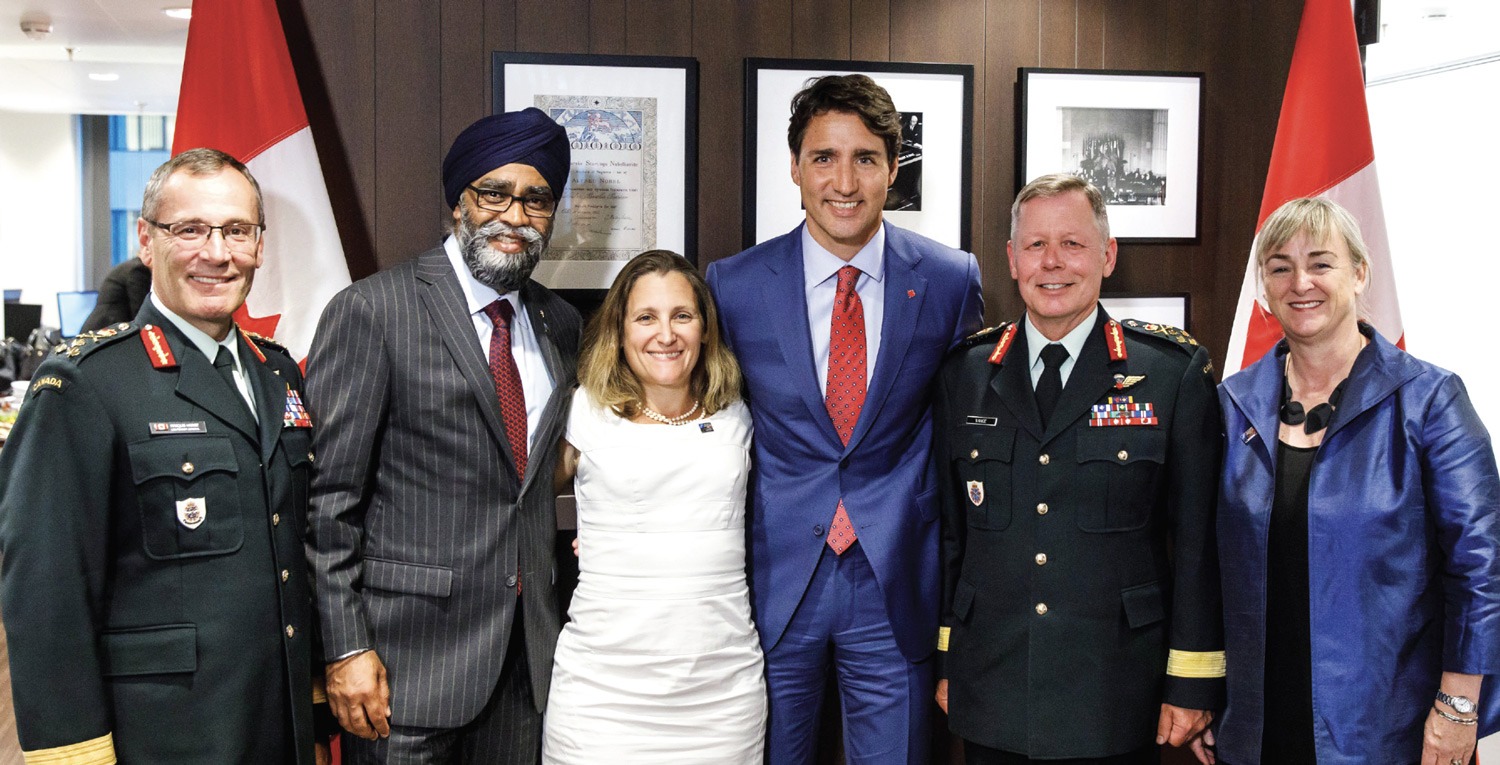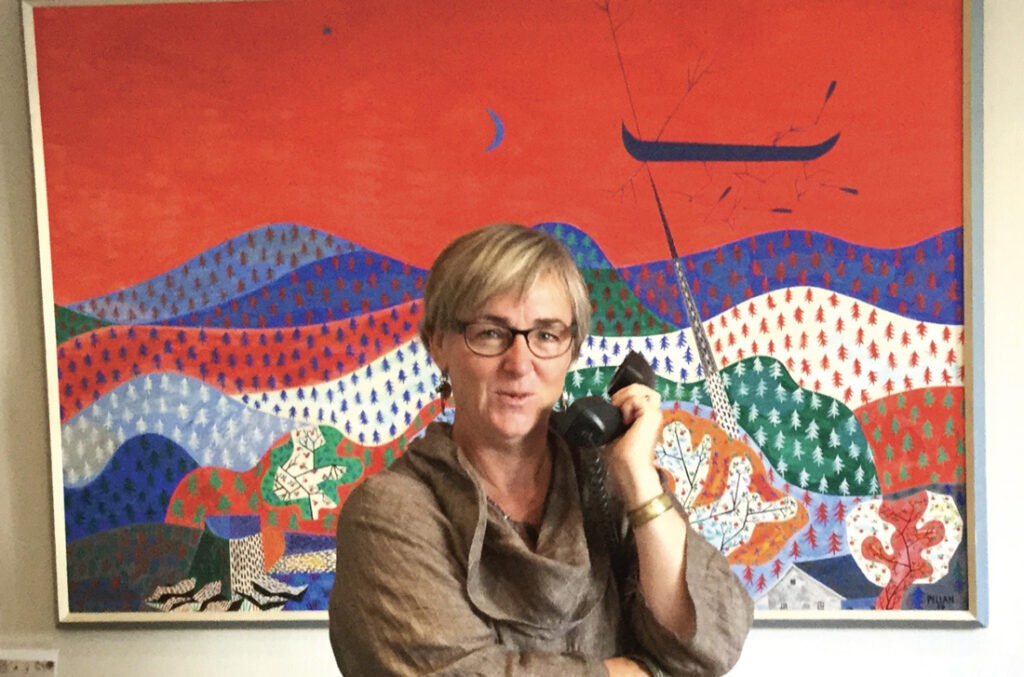Changing the Face of Security: Being a Woman Ambassador to NATO

Canada’s diplomatic corps includes high-profile women in senior roles, from Ambassador to the United States Kirsten Hillman to WTO Ambassador Nadia Theodore to Ambassador to Ukraine Larisa Galadza. Ambassador Kerry Buck served as Canada’s permanent representative to NATO from 2015 to 2018. As the first woman to serve in that role, she generously shares her experience as a woman both in the foreign service and in the male-dominated halls of NATO headquarters.
Kerry Buck
In 2015, I was appointed Canada’s Ambassador to NATO: the first woman in that position in the 66 years since Canada joined the alliance. I was not the first woman permanent representative to NATO; this honour had gone to my Lithuanian colleague in 2004, when Lithuania had joined the Alliance, appointed Ambassador Ginte Damusis and broken the glass ceiling. My American friends Toria Nuland and Rose Gottemoller became, respectively, the first American woman Ambassador to NATO (2005) and first woman Deputy Secretary General of NATO (2016). In 2015, when I arrived at NATO, there were only three other women ambassadors out of a table of twenty eight allies. They, too, were the first of their kind to be appointed by their countries.
While we in Canada tend to take gender equality as a given, the fact is that all of the NATO appointments I just listed are current events, not ancient history. The very low number of women heads of mission at the NATO table is not surprising: NATO permanent representatives are among the most senior ambassadorial appointments in western foreign ministries. The 17 (male) Canadian PermReps who preceded me included six deputy ministers of Foreign Affairs, numerous ambassadors to the United Nations and to the United States, two foreign policy advisors to the prime minister, a governor general (Jules Léger, to spare you the Googling) and a lieutenant general. NATO ambassadors are, obviously, focused on security and defence and both senior ambassadorial posts and international security are still heavily male-dominated across western allies — even more so in the rest of the world.
It can be hard to write about what it’s like to be a woman ambassador to NATO when, having never been a male ambassador, I have nothing to measure against. I can, however, reflect on my own experience making my way as a woman diplomat in the security and defence fields.
In some ways, my path to NATO ambassador followed the same arc as many of my allied colleagues. Prior to coming to Brussels, I and many of my new NATO colleagues had occupied the position of political director in our respective foreign ministries; the senior diplomat responsible for major geopolitical security issues. Every big conflict — Syria or Crimea, for instance — and every broad security issue, such as terrorism or nuclear proliferation, would end up on our desks. We negotiated with each other in the G7 and had a loose circle of political directors from other nations we reached out to when we needed to align our policy positions. I had also spent most of my 24 years as a diplomat doing multilateral negotiations.
And, as an exception to the longstanding approach of the Canadian foreign ministry to prioritize generalists, I had managed to develop a specialization in security issues. All of these factors meant that I arrived in Brussels already knowing the people and policy positions of major allies, with a solid understanding of how to negotiate at the NATO table.

These building blocks of trust and networks built over time really matter to diplomacy. Professional diplomats develop knowledge and contacts over the years that allow them to understand issues, countries and regions in-depth. This, in turn, enables them to identify early on opportunities for their countries to influence and lead. They use their international relationships to help turn opportunities into action on the ground, whether it be bolstering peace, creating new markets or development. For the NATO job, the fact that I already knew the multilateral terrain well, had gained credibility on security issues and had longstanding relationships of trust with the major voices at the NATO table, made me a more effective voice for Canada right from the start, more so than if I had been parachuted in without that background.
The day Secretary General Jens Stoltenberg formally welcomed me to NATO, the embassy put a notice out on social media. One Canadian critic used the opportunity to complain online: a) that I had no military background and b) was not a man. To be honest, I am not sure my gender had any impact on the way I approached my job as Canada’s ambassador to NATO. When I sat across the negotiating table from other NATO allies, I was “Canada” and not a woman named Kerry. In fact, a recent academic study looked at data on 80,000 ambassadorial postings and conducted in-depth interviews with 75 of them and found that most ambassadors interviewed saw no particular gender patterns within diplomacy.
What is certain, however, is that my path on the way to becoming ambassador was very much affected by my gender. Throughout my career, I had my share of explicit and implicit misogyny: one drunk boss called me into his office then angrily shoved me; another pounded on my hotel room door for hours one night, yelling to get in; yet another called me a sexist name in front of my executive committee peers – I could go on, and other women colleagues had similar experiences. What we learned from these experiences was that, although the system could offer quiet support, as with so many workplaces for so long, it was unwilling to do anything to curb the perpetrators. I hope this has changed. What I also learned was that the negative was more than offset by the colleagues, employees and mentors — both male and female — who inspired, guided and supported me throughout my diplomatic career.
When I was first appointed political director in 2010, I was only the second Canadian woman in the position. My office was on the 8th floor of the Pearson Building, the same floor as the deputy minister. At that time, there had never been a woman undersecretary of state: every morning I walked by a long line of photographs of male deputy ministers going back to 1909. In an interesting twist on this head-office reality, former head of the UK diplomatic service Sir Simon McDonald had a wall of mirrors erected in the Foreign Office, each representing a top job a woman had yet to fill, and encouraging passing women to put their face in the frame.
Senior women diplomats across countries understand how tricky it can be to be a woman working in international security. We stick together and offer support to each other in ways that male diplomats might not, because they don’t have to. I was lucky to have among my political director counterparts two colleagues who became good friends and mentors: Wendy Sherman, a senior US diplomat and Helga Schmid of the European External Action Service. Both offered invaluable support as I learned the ropes as a new political director for Canada. At one point, after I had arrived at NATO, the three of us met for dinner in Brussels. Helga and Wendy recounted a story about the casual sexism senior women diplomats still see all too frequently. The political directors who had negotiated the Iran nuclear deal were mostly women. As they were finalizing negotiations, some of the foreign ministers went out to dinner. Wendy wrote later in Politico, “As we worked to get to closure on the last details of the agreement, text messages began to transmit back to some of us that some ministers were making derogatory jokes about how much more efficient the process would have been if men were in charge.”
Wendy also told me the backstory of how she became the first woman undersecretary for political affairs at the State Department. When she was first being considered for the job, she was told there were misgivings about her as a team player. She later wrote about the experience:
“Throughout my career, I’d been called ‘tough’. It was a compliment that was regularly paid to women in Washington who demanded excellent work, but of course, it always sounded less begrudging when it was said of a man. In the competition for the political affairs job, ‘tough’ had somehow become ‘too assertive’. Critiques like this one, along with being called ‘ambitious’ or ‘aggressive,’ are often lodged against women.”
In the end, she got the job after her (male) predecessor, Bill Burns, vouched for her collegiality. I and many of my Canadian women colleagues experienced similar things: careers pushed sideways because we “took up too much space”, male-dominated policy tables that gave less weight to women’s voices, senior women moved into more “traditional” roles, for instance in human resources and out of security.
While today some of the explicit sexism has started to disappear, the power imbalances remain. I mention my own experiences and those of women colleagues because they illustrate the ways in which gender can affect not only how you do your job, but, more often, how you are seen to be doing your job. I learned that women have to work harder to be recognized and, even when they do, often need to be validated by men before it counts. As women, we need to take care not to downplay our own capabilities and to become more comfortable with power. And we need to support each other.
These are some of the lessons I had already learned by the time I arrived at NATO in the summer of 2015. I started my ambassadorial posting just as the international security environment was starting to shift away from the relative calm of the 1990s and 2000s. Russia had just invaded Crimea and allies were waking up to the need to rebuild deterrence by placing more troops in the east of the Alliance. Many more women were joining the North Atlantic Council: partway through my term I had seven women colleagues, including from the US, UK and France. And NATO Secretary General, Jens Stoltenberg, wanted to do more on gender.
To my mind, these created opportunities, and I saw room to carve out a leadership role for Canada. Although Canada had, many decades before, pulled most of our permanent troops out of Europe, our new government had also said they were “bringing Canada back” to the world stage. And “women, peace and security” had long been a Canadian priority. So I went to work, using the contacts and credibility I had at NATO and my hard-earned knowledge of how to get decisions out of the Ottawa machine. I am proud of the work I did to orchestrate Canadian command of a new battlegroup in Latvia, a role that has become even more important with Russia’s war in Ukraine. And I am proud of NATO’s adoption of its Action Plan on Women, Peace and Security, a continuation of work I started back in 1991 on the issue of violence against women. And lastly, I’m proud of the model my NATO colleagues and I set for the women who might succeed us in senior international security positions. I learned that when women take on powerful roles, they can change the way people think of the offices they fill. Or at least start to.
Kerry Buck was Canada’s Ambassador to NATO from 2015 to 2018. Prior to that she held senior diplomatic positions on International Security, Africa and the Maghreb, Latin America, the Afghanistan Task Force and the Middle East. She most recently served as Assistant Secretary to Cabinet, Economic Sector at the Treasury Board Secretariat until 2021. She is currently a Senior Fellow at the University of Ottawa and the Bill Graham Centre for Contemporary International History at Trinity College.
